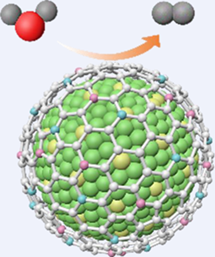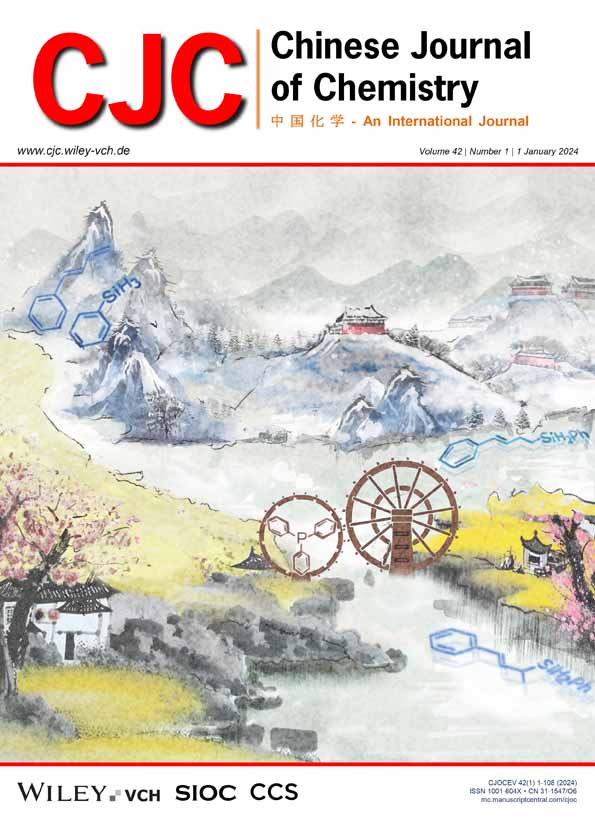Synergistic Effect of Nitrogen/Phosphorus Co-Doping and Molybdenum Carbide Induced Electron Redistribution of Carbon Layer to Boost Hydrogen Evolution Reaction†
Jiamin Xiao
College of Materials Science and Engineering, Hunan Joint International Laboratory of Advanced Materials and Technology for Clean Energy, Hunan University, Changsha, Hunan, 410082 China
These authors contributed equally to this work.
Search for more papers by this authorPeng Li
School of Chemistry, Engineering Research Center of Energy Storage Materials and Devices, Ministry of Education, Xi'an Key Laboratory of Sustainable Energy Materials Chemistry, State Key Laboratory of Electrical Insulation and Power Equipment, Xi'an Jiaotong University, Xi'an, Shaanxi, 710049 China
These authors contributed equally to this work.
Search for more papers by this authorCorresponding Author
Yanyan Sun
School of Materials Science and Engineering, Central South University, Changsha, Hunan, 410083 China
E-mail: [email protected], [email protected], [email protected], [email protected]Search for more papers by this authorHeng Liu
College of Materials Science and Engineering, Hunan Joint International Laboratory of Advanced Materials and Technology for Clean Energy, Hunan University, Changsha, Hunan, 410082 China
Search for more papers by this authorJavid Khan
College of Materials Science and Engineering, Hunan Joint International Laboratory of Advanced Materials and Technology for Clean Energy, Hunan University, Changsha, Hunan, 410082 China
Search for more papers by this authorHandong Zhang
College of Materials Science and Engineering, Hunan Joint International Laboratory of Advanced Materials and Technology for Clean Energy, Hunan University, Changsha, Hunan, 410082 China
Search for more papers by this authorHan Zhou
College of Materials Science and Engineering, Hunan Joint International Laboratory of Advanced Materials and Technology for Clean Energy, Hunan University, Changsha, Hunan, 410082 China
Search for more papers by this authorCorresponding Author
Yaqiong Su
School of Chemistry, Engineering Research Center of Energy Storage Materials and Devices, Ministry of Education, Xi'an Key Laboratory of Sustainable Energy Materials Chemistry, State Key Laboratory of Electrical Insulation and Power Equipment, Xi'an Jiaotong University, Xi'an, Shaanxi, 710049 China
Laboratory of Inorganic Materials and Catalysis, Department of Chemical Engineering and Chemistry, Eindhoven University of Technology, P.O. Box 513, 5600 MB, Eindhoven, The Netherlands
E-mail: [email protected], [email protected], [email protected], [email protected]Search for more papers by this authorCorresponding Author
Shuangyin Wang
State Key Laboratory of Chem/Bio-Sensingand Chemometrics, College of Chemistry and Chemical Engineering, Hunan University, Changsha, Hunan, 410082 China
E-mail: [email protected], [email protected], [email protected], [email protected]Search for more papers by this authorCorresponding Author
Lei Han
College of Materials Science and Engineering, Hunan Joint International Laboratory of Advanced Materials and Technology for Clean Energy, Hunan University, Changsha, Hunan, 410082 China
E-mail: [email protected], [email protected], [email protected], [email protected]Search for more papers by this authorJiamin Xiao
College of Materials Science and Engineering, Hunan Joint International Laboratory of Advanced Materials and Technology for Clean Energy, Hunan University, Changsha, Hunan, 410082 China
These authors contributed equally to this work.
Search for more papers by this authorPeng Li
School of Chemistry, Engineering Research Center of Energy Storage Materials and Devices, Ministry of Education, Xi'an Key Laboratory of Sustainable Energy Materials Chemistry, State Key Laboratory of Electrical Insulation and Power Equipment, Xi'an Jiaotong University, Xi'an, Shaanxi, 710049 China
These authors contributed equally to this work.
Search for more papers by this authorCorresponding Author
Yanyan Sun
School of Materials Science and Engineering, Central South University, Changsha, Hunan, 410083 China
E-mail: [email protected], [email protected], [email protected], [email protected]Search for more papers by this authorHeng Liu
College of Materials Science and Engineering, Hunan Joint International Laboratory of Advanced Materials and Technology for Clean Energy, Hunan University, Changsha, Hunan, 410082 China
Search for more papers by this authorJavid Khan
College of Materials Science and Engineering, Hunan Joint International Laboratory of Advanced Materials and Technology for Clean Energy, Hunan University, Changsha, Hunan, 410082 China
Search for more papers by this authorHandong Zhang
College of Materials Science and Engineering, Hunan Joint International Laboratory of Advanced Materials and Technology for Clean Energy, Hunan University, Changsha, Hunan, 410082 China
Search for more papers by this authorHan Zhou
College of Materials Science and Engineering, Hunan Joint International Laboratory of Advanced Materials and Technology for Clean Energy, Hunan University, Changsha, Hunan, 410082 China
Search for more papers by this authorCorresponding Author
Yaqiong Su
School of Chemistry, Engineering Research Center of Energy Storage Materials and Devices, Ministry of Education, Xi'an Key Laboratory of Sustainable Energy Materials Chemistry, State Key Laboratory of Electrical Insulation and Power Equipment, Xi'an Jiaotong University, Xi'an, Shaanxi, 710049 China
Laboratory of Inorganic Materials and Catalysis, Department of Chemical Engineering and Chemistry, Eindhoven University of Technology, P.O. Box 513, 5600 MB, Eindhoven, The Netherlands
E-mail: [email protected], [email protected], [email protected], [email protected]Search for more papers by this authorCorresponding Author
Shuangyin Wang
State Key Laboratory of Chem/Bio-Sensingand Chemometrics, College of Chemistry and Chemical Engineering, Hunan University, Changsha, Hunan, 410082 China
E-mail: [email protected], [email protected], [email protected], [email protected]Search for more papers by this authorCorresponding Author
Lei Han
College of Materials Science and Engineering, Hunan Joint International Laboratory of Advanced Materials and Technology for Clean Energy, Hunan University, Changsha, Hunan, 410082 China
E-mail: [email protected], [email protected], [email protected], [email protected]Search for more papers by this authorDedicated to the Special Issue of Electrocatalysis.
Comprehensive Summary
The development of highly efficient non-precious-metal-based electrocatalysts for the hydrogen evolution reaction is imperative for promoting the large-scale application of electrochemical water splitting. Herein, nitrogen/phosphorus co-doped carbon nanorods encapsulated Mo2C nanoparticles (Mo2C@PNC) have been prepared by pre-phosphating treatment in combination of the coordination with polydopamine and the subsequent pyrolysis. The phosphating temperature has a significant effect on the content of phosphorus within the resultant Mo2C@PNC, and the optimal catalyst delivers superior HER activity with the low overpotential of 104 mV at a current density of 10 mA·cm–2 and good stability for 8 h, which has been theoretically demonstrated to originate from the synergistic effect between P doping and Mo2C induced electron redistribution of nitrogen-doped carbon layer.
Supporting Information
| Filename | Description |
|---|---|
| cjoc202300400-sup-0001-supinfo.pdfPDF document, 1.9 MB |
Appendix S1: Supporting Information |
Please note: The publisher is not responsible for the content or functionality of any supporting information supplied by the authors. Any queries (other than missing content) should be directed to the corresponding author for the article.
References
- 1 Wu, Z.; Zhao, Y.; Xiao, W.; Fu, Y.; Jia, B.; Ma, T.; Wang, L. Metallic-Bonded Pt-Co for Atomically Dispersed Pt in the Co4N Matrix as an Efficient Electrocatalyst for Hydrogen Generation. ACS Nano 2022, 16, 18038–18047.
- 2 Chen, G.; Wang, T.; Zhang, J.; Liu, P.; Sun, H.; Zhuang, X.; Chen, M.; Feng, X. Accelerated Hydrogen Evolution Kinetics on NiFe-Layered Double Hydroxide Electrocatalysts by Tailoring Water Dissociation Active Sites. Adv. Mater. 2018, 30, 1706279.
- 3 Zhang, Z.-Y.; Tian, H.; Bian, L.; Liu, S.-Z.; Liu, Y.; Wang, Z.-L. Cu-Zn-based alloy/oxide interfaces for enhanced electroreduction of CO2 to C2+ products. J. Energy Chem. 2023, 83, 90–97.
- 4 Ma, F. X.; Wu, H. B.; Xia, B. Y.; Xu, C. Y.; Lou, X. W. Hierarchical β-Mo2C Nanotubes Organized by Ultrathin Nanosheets as a Highly Efficient Electrocatalyst for Hydrogen Production. Angew. Chem. Int. Ed. 2015, 54, 15395–15399.
- 5 Luo, M.; Yang, J.; Li, X.; Eguchi, M.; Yamauchi, Y.; Wang, Z.-L. Insights into alloy/oxide or hydroxide interfaces in Ni–Mo-based electrocatalysts for hydrogen evolution under alkaline conditions. Chem. Sci. 2023, 14, 3400–3414.
- 6 Shi, C.; Li, X.; Yang, W.; Liu, X.; An, Y.; Zhou, L.; Mai, L. Anchoring ultra-small Mo2C nanocrystals on honeycomb-structured N-doped carbon spheres for efficient hydrogen evolution. Chem. Commun. 2022, 58, 5269–5272.
- 7 Lu, Y.; Yue, C.; Li, Y.; Bao, W.; Guo, X.; Yang, W.; Liu, Z.; Jiang, P.; Yan, W.; Liu, S.; Pan, Y.; Liu, Y. Atomically dispersed Ni on Mo2C embedded in N, P co-doped carbon derived from polyoxometalate supramolecule for high-efficiency hydrogen evolution electrocatalysis. Appl. Catal. B: Environ. 2021, 296, 120336.
- 8 Liu, Z.; Zhou, S.; Xue, S.; Guo, Z.; Li, J.; Qu, K.; Cai, W. Heterointerface-rich Mo2C/MoO2 porous nanorod enables superior alkaline hydrogen evolution. Chem. Eng. J. 2021, 421, 127807.
- 9 Wang, B.; Huang, Y.; Ai, Y.; Yao, Y.; Shi, F.; Xu, S.; Zhang, Z.; Wang, X.; Sun, W. Synergistically coupling P-doped Mo2C@N, P dual-doped carbon-nanoribbons as an efficient electrocatalyst for the hydrogen evolution reaction. New J. Chem. 2022, 46, 11389–11397.
- 10 Shi, Z.; Nie, K.; Shao, Z.-J.; Gao, B.; Lin, H.; Zhang, H.; Liu, B.; Wang, Y.; Zhang, Y.; Sun, X.; Cao, X.-M.; Hu, P.; Gao, Q.; Tang, Y. Phosphorus-Mo2C@carbon nanowires toward efficient electrochemical hydrogen evolution: composition, structural and electronic regulation. Energy Environ. Sci. 2017, 10, 1262–1271.
- 11 Xiao, J.; Zhang, S.; Sun, Y.; Liu, X.; He, G.; Liu, H.; Khan, J.; Zhu, Y.; Su, Y.; Wang, S.; Han, L. Urchin-Like Structured MoO2/Mo3P/Mo2C Triple-Interface Heterojunction Encapsulated within Nitrogen-Doped Carbon for Enhanced Hydrogen Evolution Reaction. Small 2023, 19, e2206472.
- 12 Lin, H.; Liu, N.; Shi, Z.; Guo, Y.; Tang, Y.; Gao, Q., Cobalt-Doping in Molybdenum-Carbide Nanowires Toward Efficient Electrocatalytic Hydrogen Evolution. Adv. Funct. Mater. 2016, 26, 5590–5598.
- 13 Chang, H.-Q.; Zhang, G.-H.; Chou, K.-C. Synthesis of Mo2C/MoC and Mo2C/MoC/MoP heterostructures supported on N-doped carbon as electrocatalyst for high-efficient hydrogen evolution reaction. Electrochim. Acta 2021, 394, 139119.
- 14 Zhang, C.; Liu, Q.; Wang, P.; Zhu, J.; Chen, D.; Yang, Y.; Zhao, Y.; Pu, Z.; Mu, S. Molybdenum Carbide-PtCu Nanoalloy Heterostructures on MOF-Derived Carbon toward Efficient Hydrogen Evolution. Small 2021, 17, e2104241.
- 15 Xu, J.; Ge, L.; Zhou, Y.; Jiang, G.; Li, L.; Li, Y. Insights into N, P, S multi-doped Mo2C/C composites as highly efficient hydrogen evolution reaction catalysts. Nanoscale Adv. 2020, 2, 3334–3340.
- 16 Huang, X.; Xu, X.; Li, C.; Wu, D.; Cheng, D.; Cao, D. Vertical CoP Nanoarray Wrapped by N, P-Doped Carbon for Hydrogen Evolution Reaction in Both Acidic and Alkaline Conditions. Adv. Energy Mater. 2019, 9, 1803970.
- 17 Li, M.; Zhu, Y.; Wang, H.; Wang, C.; Pinna, N.; Lu, X. Ni Strongly Coupled with Mo2C Encapsulated in Nitrogen-Doped Carbon Nanofibers as Robust Bifunctional Catalyst for Overall Water Splitting. Adv. Energy Mater. 2019, 9, 1803185.
- 18 He, G.; Liu, H.; Liu, X.; Zhu, Y.; Xiao, J.; Han, L. Cu-doped molybdenum carbide encapsulated within two-dimensional nanosheets assembled hierarchical tubular nitrogen-doped carbon for enhanced hydrogen evolution. J. Electroanal. Chem. 2021, 900, 115731.
- 19 Zhang, X.; Lei, T.; Xia, M.; Wei, Q. H.; Xie, Z. Core-shell Mo2C@NC/Mo2C hollow microspheres as highly efficient electrocatalysts for the hydrogen evolution reaction. Dalton Trans. 2023, 52, 6267–6272.
- 20 Song, Y.-J.; Ren, J.-T.; Yuan, G.; Yao, Y.; Liu, X.; Yuan, Z.-Y. Facile synthesis of Mo2C nanoparticles on N-doped carbon nanotubes with enhanced electrocatalytic activity for hydrogen evolution and oxygen reduction reactions. J. Energy Chem. 2019, 38, 68–77.
- 21 Chai, L.; Zhang, L.; Wang, X.; Ma, Z.; Li, T.-T.; Li, H.; Hu, Y.; Qian, J.; Huang, S. Construction of hierarchical Mo2C nanoparticles onto hollow N-doped carbon polyhedrons for efficient hydrogen evolution reaction. Electrochim. Acta 2019, 321, 134680.
- 22 Sun, Y.; Li, S.; Paul, B.; Han, L.; Strasser, P. Highly efficient electrochemical production of hydrogen peroxide over nitrogen and phosphorus dual-doped carbon nanosheet in alkaline medium. J. Electroanal. Chem. 2021, 896, 115197.
- 23 Chen, Y. Y.; Zhang, Y.; Jiang, W. J.; Zhang, X.; Dai, Z.; Wan, L. J.; Hu, J. S. Pomegranate-like N, P-Doped Mo2C@C Nanospheres as Highly Active Electrocatalysts for Alkaline Hydrogen Evolution. ACS Nano 2016, 8851–8860.
- 24 Tan, J.; He, X.; Yin, F.; Liang, X.; Chen, B.; Li, G.; Yin, H. β-Mo2C/N, P-co-doped carbon as highly efficient catalyst for hydrogen evolution reaction. J. Mater. Sci. 2018, 54, 4589–4600.
- 25 Han, L.; Yu, X. Y.; Lou, X. W. Formation of Prussian-Blue-Analog Nanocages via a Direct Etching Method and their Conversion into Ni-Co-Mixed Oxide for Enhanced Oxygen Evolution. Adv. Mater. 2016, 28, 4601–4605.




